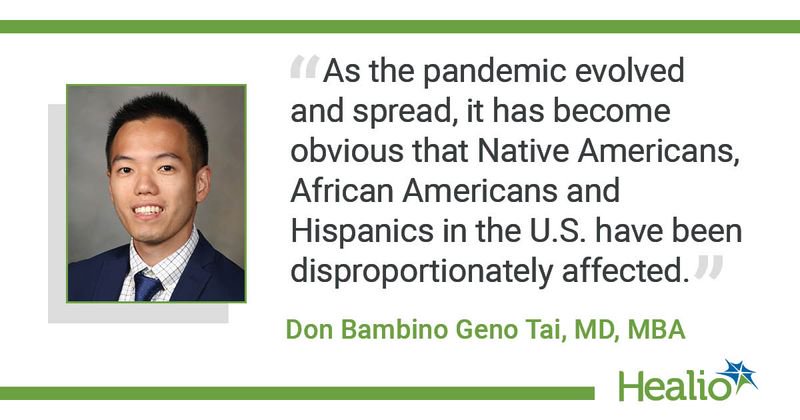Q&A: Addressing racial disparities in COVID-19
Although COVID-19 has significantly affected people across the world, in the U.S., racial and ethnic minority groups have had a particularly high burden.
Since the start of the pandemic, studies have shown that Black and Hispanic communities accounted for disproportionately high hospitalization and death rates from COVID-19, and experts have pointed to pre-existing barriers as a potential driving factor in these disparities.

A paper accepted by Clinical Infectious Diseases examined the long-standing structural, societal and biomedical factors that led to disparities in the COVID-19 burden among Black, Latinx and Native American communities in the U.S. and explained the implications they have for clinicians.
Healio Primary Care spoke with Don Bambino Geno Tai, MD, MBA, co-author of the paper and a physician in the division of infectious diseases at Mayo Clinic, to learn more about the findings and what primary care physicians can do to address racial disparities in COVID-19.
Q: Why is it important to address and acknowledge racial disparities in COVID-19?
A: The COVID-19 pandemic was initially called the great equalizer. It was thought that no matter where you are, who you are, how rich or poor, what the color of your skin is, everyone is at risk. However, as the pandemic evolved and spread, it has become obvious that Native Americans, African Americans and Hispanics in the U.S. have been disproportionately affected. Acknowledging this fact is only the first step in rectifying the injustice. There is no excuse in letting this continue to happen.
Q: What are the biomedical reasons behind the disproportionate burden of COVID-19 among racial and ethnic minority groups?
A: There are some chronic medical conditions that put some patients at risk for severe disease. Diabetes, hypertension, kidney disease and obesity are some of the risk factors associated with poorer outcomes in COVID-19. Native Americans, African Americans and Hispanics have disproportionately higher prevalence of some of these comorbidities. However, we cannot stress enough the impact of social determinants of health in causing these comorbidities.
Q: What are the social determinants of health driving the disproportionate burden of COVID-19 in racial and ethnic minority groups?
A: Social determinants of health are the focus of our paper. Probably the biggest reasons for the disproportionate burden are due to these. The continued systemic racism, social injustice [and the] legacy of redlining have led to health disparities and financial conditions that put some racial and ethnic minorities in a precarious situation during the pandemic. We have laid out some more examples like pollution, quality of health care and housing insecurity.
Q: How can PCPs mitigate the increased risk for death from COVID-19 in Black, Latinx and Native American communities?
A: Health care providers should address implicit bias. Establishing great rapport with patients achieves better outcomes. Patients under our care should get optimal management of their chronic medical conditions and prevention of reversible risk factors.
Q: What public health efforts are needed to address racial disparities in the COVID-19 burden in the U.S.?
The CDC has guidance on reducing the impact of COVID-19 on racial and ethnic minorities. I like their recommendation for proper collection of data, especially on race and ethnicity. Not all states are reporting this data. I also agree on working with community-based organizations and having culturally sensitive health care with language services.

